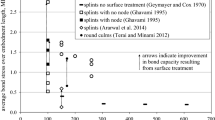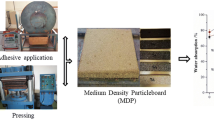Abstract
The purpose of this study was to investigate the creep behaviour of commercial wood based boards (sanded and laminated) under long-term loading at room conditions in Taiwan. Ten types of commercial wood based boards were used to test their physical and mechanical properties in this study. Four types of these boards were used for the same test after laminating with red oak (Quercus spp.) veneer or balanced paper. The bending creep was measured at room conditions with central concentrated loading. The values for creep deflection of commercial wood based boards 18 mm thick decreased from 1.06–1.19 mm ti 1.00–1.12 mm after laminating veneer or balanced paper. The relative creep (120 days) of those specimens decreased from 1.71–3.17 to 1.43–2.04 after laminating with veneer or balanced paper in four months’ loading. The creep deflections of specimens increased with increasing loading time. The linear regression function ist/y=a+bt, wheret is time,y is deflection. When theb value is larger, the boards displayed good creep resistance. The residual bending strength of wood based boards after creep test would be retained at about 80–95%, and the residual bending strength between particleboard proved more significant than between fiberboard.
Zusammenfassung
Physikalische und mechanische Eigehschaften von 10 kommerziellen Holzwerkstoffentypen wurden zuerst untersucht; davon wurden vier nach Beschichtung mit Eichenfurnier oder Papier die Eigenschaften auch zum Vergleich bestimmt. Die Kriechenuntersuchung wurde mit Mittenbelastung unter Raumbedingung durchgeführt. Die Durchbiegung (Plattendicke 18 mm) nimmt während 4-monatiger Belastung mit der Beschichtung, von 1.06–1.19 mm zu 1.00–1.12 mm ab. Aufgrund der Beschichtung zeigte die relative Durchbiegung eine Abnahme von 1.71–3.17 auf 1.43–2.04 mm. Das Durchbiegungsmaß nimmt mit zunehmender Belastungszeit zu nach einer linearen Regression:t/y=a+bt, wobeit Belastungszeit undy die Durchbiegung sind. Ein hoher b-Wert bedeutet demnach einen hohen Kriechwiderstand. Die verbleibende Biegefestigkeit der beschichteten Holzwerkstoffe nach dieser Durchbiegungsuntersuchung betrug noch etwa 80–9%. Zwischen den Spanplattentypen waren die Unterschiede größer als zwischen den Faserplatten.
Similar content being viewed by others
References
Dunlop JI (1980) Testing of Particleboard by Acoustic Technique. Wood Sci. Technol. 14: 69–78
Hearmon RFS, Paton JM (1964) Moisture Content Changes and Creep of Wood. Forest Prod. J. Bd XVI: 357–359
Martensson A (1988) Tensile Behaviour of Hardboard Under Combined Mechanical and Moisture Loading. Wood Sci. Technol. 22: 129–142
Smulski SJ (1989) Creep Functions for Wood Composite Materials. Wood Fiber Sci. 21(1): 45–54
Tang RC, Yeh PMC (1987) Viscoelastic Properties and Durbility of Wood Composite Board under Changing Humidity. Auburn University, Alabama, U.S.A.. Conditions USFS 19-82-062 School of Forestry Auburn
Author information
Authors and Affiliations
Additional information
A part of Research projects sponsored by the National Science Council (NSC 79-0409-B005-31, NSC 80-0409-B005-35); Also a Voluntary paper for IUFRO Division 5 conference Forest products, Nancy/France, Aug. 23–28 1992.
Rights and permissions
About this article
Cite this article
Chen, T.Y., Lin, J.S. Creep behaviour of commercial wood based boards under long-term loading at room conditions in Taiwan. Holz als Roh- und Werkstoff 55, 371–376 (1997). https://doi.org/10.1007/s001070050249
Issue Date:
DOI: https://doi.org/10.1007/s001070050249




